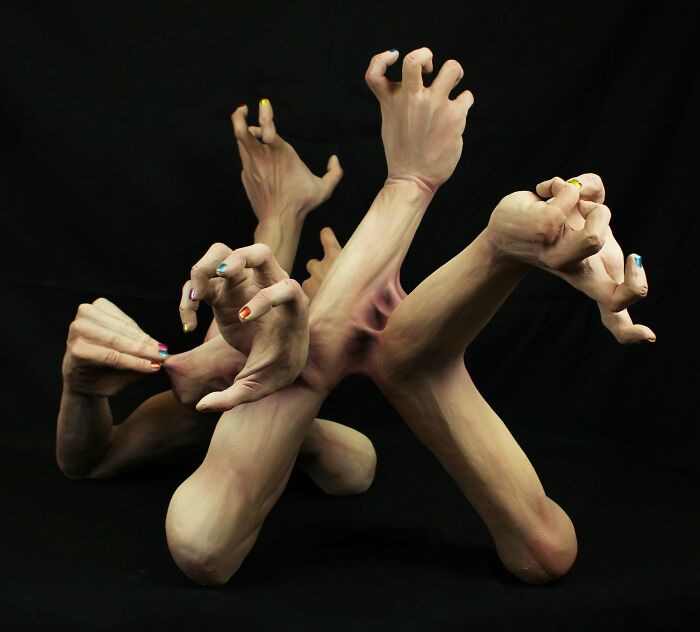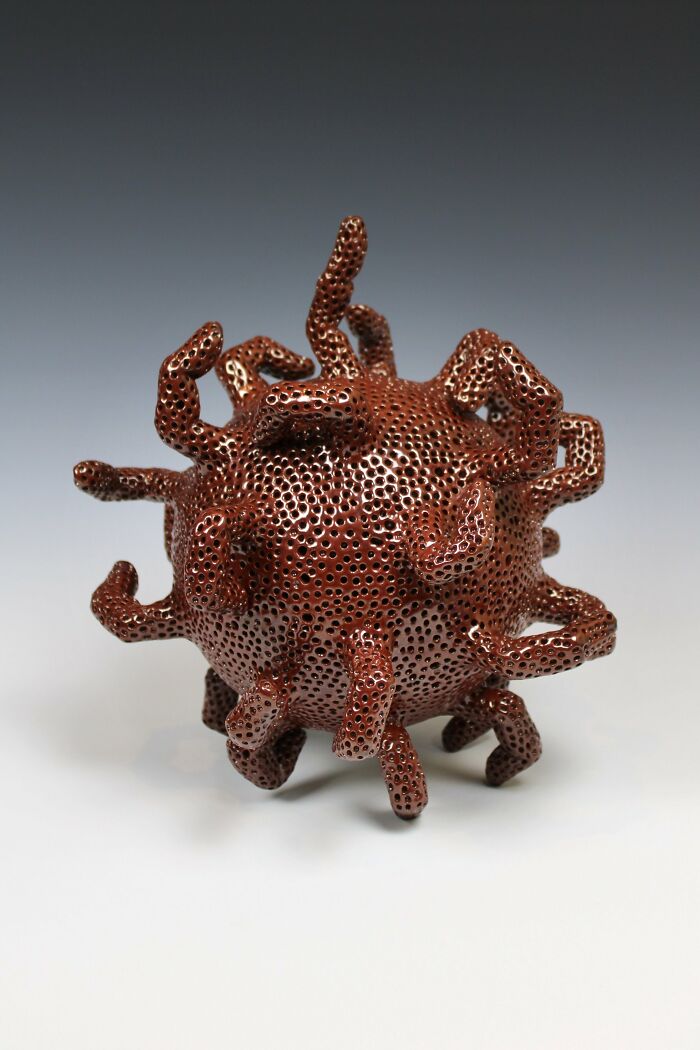Screaming faces, restless hands, and soul-like figures struggling to escape their vessels—these are the striking elements that first draw attention to Jackson Shaner's art. He is a ceramic artist whose work explores themes of emotional containment, monstrosity, and human connection through surreal and intricately crafted pieces.
Shaner’s artwork acts as a metaphor for how we hold in emotions, only letting them out in certain moments. He shows how emotions can become physical sensations of pain and restriction, often leading to feelings of vulnerability.
More info: Instagram | jacksonshaner.com
This post may include affiliate links.
Large Raw Porcelain Escape Jar 2
Bored Panda had the chance to interview Jackson Shaner to dive deeper into the inspiration behind his unique creations. The artist shared that he has been creating objects since he was a child. "I was lucky enough to have a small art project in the 4th grade that introduced me to clay as a medium. Since I live in South Carolina, and there is a tradition of face-jug pottery in the South, our teacher had us try our hand at coil-building small face jugs. I remember being extremely attracted to the immediacy in which you can alter clay using your hands. There is often no intermediary between hand and material like there is in painting (paintbrush), drawing (pencil), photography (camera), or graphic design (computer). There is a rawness in the creation process wherein you feel intimately connected with the material, transforming the clay through touch."
When asked what drew him to ceramics, Shaner explained that he is fascinated by clay's ability to be both additive and subtractive, allowing him to shape and mold it in unique ways. "I have always been inspired by classical and Hellenistic Greek sculpture, but to me, working only subtractively is accompanied by a heightened fear of failure: if you chip a bit too far, there’s no going back. Clay is not like that. In this way, clay can be very forgiving. If you make a mistake, you can pull off a nose, an ear, a finger...re-sculpt, and reattach. This forgiveness, while the clay is wet, also affords greater opportunity for playful experimentation in the building process. Playfulness is a very engaging part of how I work."
Skin
Searching For Comfort
Shaner shared that he is deeply engaged in the process of shaping something from a formless state into a finished piece. "I think that is one of the most magical things about ceramics. To create with clay is to work from chaos, using a soft base material and transforming it into anything you like. This means that, in theory, every detail can be controlled by the artist. There is something to be said about showing off clay’s raw materiality in looser sculpture, but in much of my work, I aim to address every detail of a three-dimensional object. Three-dimensionality is also important in my work both conceptually and aesthetically. I love the ability to create something that takes up real space. Sculptural artists are all out here 'holding space' for what we believe in (#wickedmovie ... lol)."
When discussing his passion for ceramics, Shaner mentioned permanence. "One of the reasons we can learn so much about ancient cultures is because we can examine their uses of ceramics. We can look at a culture’s sculptural forms to learn about its values. We can examine a culture’s pots to imagine its way of life. I am always aware when I create that whatever I make—if it is not destroyed—will very likely outlive me, perhaps even for thousands of years. In this way, each pot or sculpture can be viewed as a letter to the future: communicating intimate information across time and language barriers."
Sublimate 2
Sublimate 1
Shaner’s work often revolves around themes of tension, discomfort, and the uncanny, reflecting his personal emotions and experiences. These themes play a key role in how he expresses complex feelings through ceramics. According to the artist, the uncanny is something he has been looking into recently. "I have been reading about Freud’s early work on the uncanny and the historical uses of monsters in literature and movies as symbols for those who have felt 'othered' (or for those that feel they lack belonging). Sometimes, I do strike a sense of community where I am, but growing up as a gay man in the South, I have always had social anxiety about expressing things in the wrong way: either too effeminately, or in an 'outing' nature. I remember feeling that anxiety even in middle school. I think the culture surrounding appropriate behavior for young boys in America can be incredibly stifling. And, learning to exist in that state of anxiety caused me to create many defense mechanisms against potential ridicule: often masking and mirroring."
Centipede
Xl Copper Escape Jar
Shaner explores themes of containment and monstrosity in his work as reflections of his personal experiences. Containment relates to his tendency to suppress parts of his personality for the sake of safety, a habit he still occasionally faces in situations like entering a hardware store or attending a sports event. Monstrosity represents his feelings of not fully belonging.
"As long as I can remember, I have almost always employed at least some degree of mirroring when interacting with someone to ensure I am accepted in the interaction. I guess it stems from a deep-seated fear of rejection. And I think every queer man has had the experience of 'putting on their straight voice' as a t**l for self-preservation in an unwelcoming environment. Although I can’t remember an outstanding hateful interaction, simply knowing that I exist in a hostile political environment filled with people who do not accept me and might like to do harm to me, leads to a sort of existential anxiety. (I am in no way the first queer artist to experience this.)"
Panic
Tension
Shaner enjoys exploring the balance between attraction and aversion, drawing a fine line between beauty and horror in his work. "I think it’s a more faithful representation of what it means to be human. There is nothing that is solely beautiful. Even our bodies, which are often the objects of sexual desire, have elements that disgust most.
"I also think people have a desire to experience confusion and fear in a safe space. I think that is why there is such a wide horror culture in movies and literature. I want to contribute to that stirring dichotomy between attraction and fear: wanting to move closer for a better look, but the tentative possibility that this creature could come alive and harm me. There is something exciting about the moment one chooses to dive in and keep looking. There is a naughtiness: a feeling that one shouldn’t be looking at what they are seeing. And there is a reciprocal mischievousness on my part for surfacing something that addresses pain, anxiety, or disgust."
Red Iron Oxide Escape Jar
Large Custom Escape Jar
Creative work often comes with its own set of challenges. For Shaner, these challenges include deciding how much to reveal in his pieces, figuring out how to bring his vision to life architecturally, and dealing with setbacks like cracks or explosions in the kiln. These obstacles require both creative and mental resilience as part of the artistic process.
"Sometimes, I will start a project even if I am not ready to talk about its content. My time with the piece in my studio can consist of me grappling with or even exploring the content to better understand myself. This can be incredibly cathartic and healing. But often I need some time before I talk about it. Luckily, the way I create is without language, and people always attribute their own associations to my work... 'bring their own s**t,' as one might say. It only becomes an issue when I am required to talk about it in a scholarly setting. But I am getting better at setting boundaries with some pieces. Saying... 'no, I’m not ready to talk about this one yet.''"
Tantrum
Veiled Ambivalence
The architecture of Shaner's work comes with its own set of difficulties. "I like to push myself to create bigger and more dynamic pieces, and that is often accompanied by failure. One of the biggest challenges is negotiating moisture control: making sure whatever I have built, and am continuing to build off of, can support a new layer of clay by being dry enough to be stiff and stable, but not too dry to be brittle. I also tend to want to address the overall surface later on, so I have to conserve moisture in the lower sections of a piece, but not so much that it is floppy and weak. I find that thinking through the assembly of a piece and preparing the necessary supports and precautions is vital when it comes to a complex form.
"And yes, I do have the occasional explosion or large crack in the kiln. It is much less frequent now than it used to be, but in this case, prevention is the best solution. I am constantly struggling against my own impatience, and ceramics often requires a slower, methodical approach. There are always 1,000 things that can go wrong, and getting good is knowing how to prevent each of those issues in the drying and firing process."
Caliban
Puffy Cheeks Jar
Despite the challenges, Shaner mentioned that there are many rewarding parts to his work. "Sometimes the most rewarding aspect of ceramics is getting to externalize and separate all the s**t I’m dealing with from myself. I can come back in a few days and reexamine a piece for what it is now that I am removed from its creation. What does it hold and communicate now, as a stand-alone object? How do I feel lighter getting some s**t out of my chest?
"I would be lying if I did not mention that a 'like, comment, and share' count is a source of gratification. With the sort of 'attention economy' we have on social media, it feels good to see that I have something to contribute and that people will take 17 seconds to look at my work. I feel that that's what we artists on social media are doing, we are all just competing for people's attention. How can I make someone look at and think about my work? How can I make someone care? I didn't feel right not mentioning this, though it is definitely not the most rewarding.
"I suppose the most rewarding part of ceramics is seeing and hearing how other people connect with my work, especially in person. I absolutely love it when someone at a show comes up to me to express how what I have made reflects some aspect of their inner self. Or perhaps it touches on a hardship that they have been going through. I have gotten some pretty intimate conversations started that way. There is a quieter and stronger bond that comes from sharing trauma with another. In a society which is coded by lots of surface conversation and small talk, true expression of personal meaning, especially with a stranger, is no small thing."
Soda Fired Escape Jar
Infectious | Red
Superb works of art and craft. A shame that so many of them feel like nightmare fuel for me at least.
Superb works of art and craft. A shame that so many of them feel like nightmare fuel for me at least.

 Dark Mode
Dark Mode 

 No fees, cancel anytime
No fees, cancel anytime 


















































